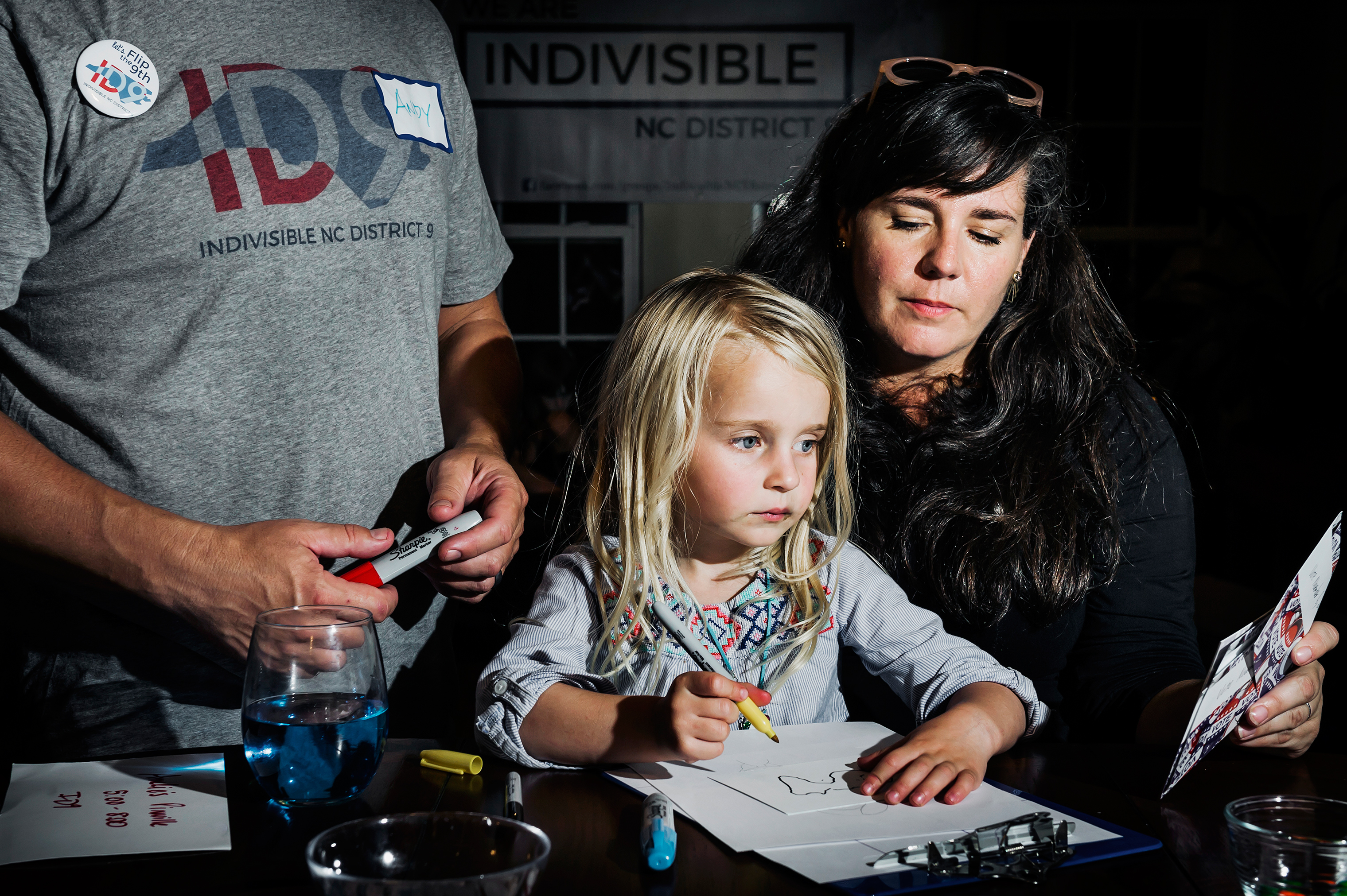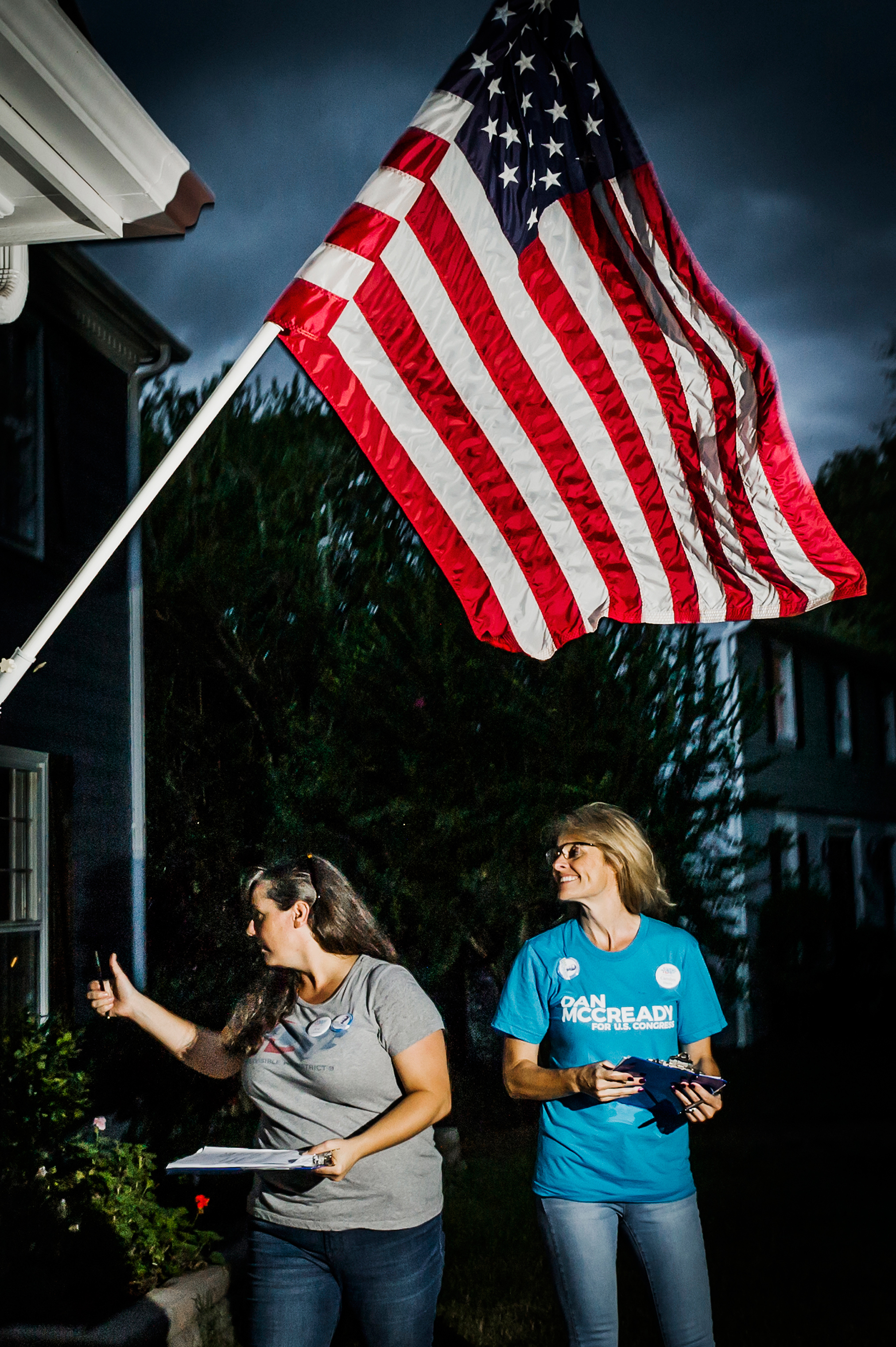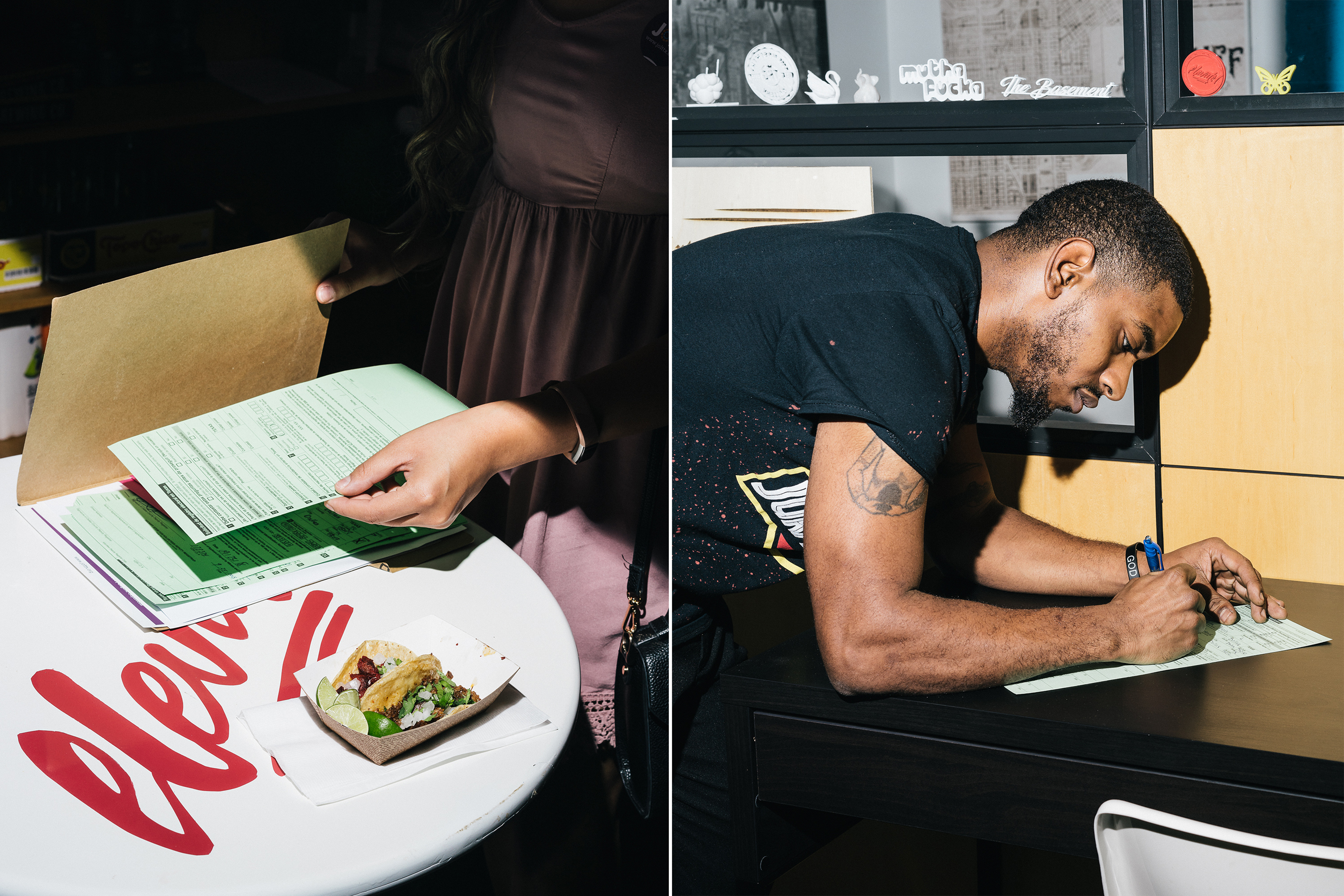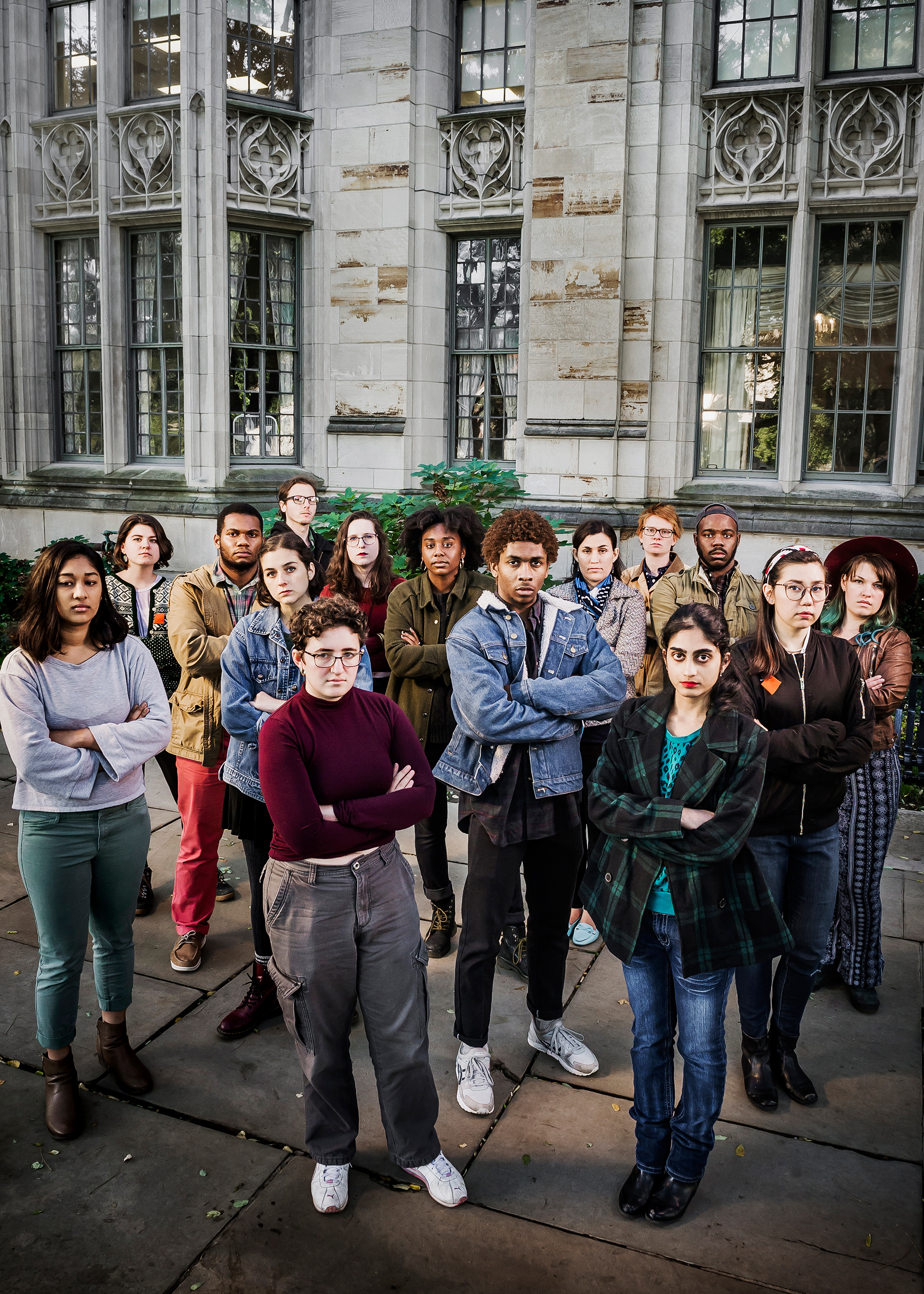Carolyn Eberly is an unlikely warrior. A former chemist from Waxhaw, N.C., she works at the local library, plays volleyball and wears her blond hair pulled back in a big clip. Her husband has always followed politics, but Eberly used to steer away from it in polite conversation. She voted, but not much else.
Then came President Donald Trump’s election. “I felt sick to my stomach,” says Eberly, 51. She found herself at the Women’s March in Charlotte, then at rallies for immigrants, then staying up all night reading news articles posted in Facebook groups. She began to feel uncomfortable around her neighbors who voted for Trump and around her volleyball friends who didn’t seem to care about politics. The day after the Women’s March, she saw on Facebook that a woman who lived an hour away was hosting a letter-writing party to pressure local elected officials. Eberly couldn’t make it over, so the woman suggested she host her own event.
Eberly typed up an invitation. Just before she posted it on Facebook, she paused. “You ever have a premonition?” she says, sipping a smoothie at a Panera Bread near her home. “Where you think, ‘This could change my life’?”
Twelve people responded to Eberly’s post. Three showed up. And Indivisible N.C. District 9 was born. Since then, more than 1,000 people have joined either its Facebook group or its email list. In February 2018, long before there was a Democratic nominee in their House district, Eberly and her team began knocking on doors to build rapport with their neighbors and hear about their political priorities, a process called “deep canvassing.” When a Marine veteran and solar-energy entrepreneur named Dan McCready won the Democratic primary in May, Eberly and her friends went back to the same doors they had knocked on months earlier—this time, they were armed with his campaign literature.
North Carolina’s 9th District, which stretches from the Charlotte suburbs into more conservative rural areas, has been in GOP hands for more than 50 years. Trump won it by 12 points in 2016. But grassroots efforts like Eberly’s have helped transform the race into a toss-up contest, according to the nonpartisan Cook Political Report. McCready has raised four times as much money as his Republican opponent, pastor Mark Harris, and he sees groups like Eberly’s as key to his victory. “No dark money,” McCready says, “can stop a neighbor talking to another neighbor at their door.”

Indivisible N.C. 9 is just one platoon in a volunteer army that has stormed the field after Trump’s election in 2016. The forces are vast and decentralized; they have different ideologies and support different kinds of candidates. But they’re united by a common mission: to oppose Trump’s policies, pressure their local Republican representatives and elect Democrats to replace them in the Nov. 6 midterms.
Some of these activists call themselves “the Resistance.” Trump and his allies call them an “angry mob.” On the ground it’s just called participatory democracy. Hundreds of thousands of volunteers, allied with thousands of autonomous groups, are doing the grunt work of propelling their neighbors to the polls, using tactics tailored to their communities. Suburban moms are knocking on doors in North Carolina battlegrounds; racial-justice organizers in Georgia are mobilizing black voters in churches and restaurants; college students in Pennsylvania are using social media to reach new voters. In Texas, immigrant-rights activists are helping Latino voters get their paperwork in order. Teenage gun-safety advocates from Florida are on bus tours to register other newly eligible voters.
The grassroots groundswell is already translating into dollars and votes. Democratic candidates have raised more than $850 million through the online fundraising platform ActBlue, more than five times as much as in the 2014 midterms. With an average donation of around $50, Democrats are trouncing Republicans in the chase for campaign cash, leading the GOP in more than 30 of the most competitive House races.
All that money is evidence of a Democratic base that seems to have risen from its stupor. Democrats cast nearly twice as many votes in the 2018 primaries as they did four years earlier, according to Pew Research Center, outpacing Republicans by more than 4 million. Eighty-one percent of Democratic-leaning voters say they are certain to vote in the midterms, up more than 20 points from 2014, according to a Washington Post/ABC poll. That same poll found Republican enthusiasm up 3 points.
It’s not that the Democrats are being pulled left. It’s more that Democrats are being pulled local. And while ideas like “Medicare for all” and “Abolish ICE” have spread far beyond the party’s left flank, the anti-Trump resistance movement is ultimately more results-driven than ideological. What works for voters in the Bronx may not work for voters in Iowa, and in the midterms it doesn’t have to. The party seems to be relearning the central lesson of American democracy: what 19th century French writer Alexis de Tocqueville called “the knowledge of how to combine.”

If Democrats retake one or both houses of Congress in November, it will be largely because of this emerging national network of progressive organizers. But winning the midterms is just the first step, they say, in a movement designed to rebuild and transform local party infrastructure that had been hollowed out during Barack Obama’s presidency. During those eight years, Democrats lost 13 governorships and nearly 900 state legislative seats, along with their majorities in both the House and Senate. State parties atrophied; local activists grew disengaged. Now these organizers are helping to build a new Democratic pipeline, nominating a historic number of women and people of color and repopulating state and local races with energetic young candidates.
The result is not only a new class of candidates to run in 2018, 2020 and beyond. It could also change the structure of the Democratic Party itself. Already, activists have forced the Democratic National Committee to overhaul its superdelegate system. All the party’s old rules about who should run for which seats “have been thrown out the window,” says Jane Kleeb, chair of the Nebraska Democratic Party. Advocacy groups that previously stayed out of electoral politics are now downloading voter files and knocking on doors. “It’s transforming the way we run state parties,” she says. “They’re coming up with new ideas that are going to help our candidates win.”
On a swampy Monday in July, Eberly and her co-leaders are rolling up little slices of turkey and pepperoni and putting together skewers of tomato and mozzarella. It’s steaming hot, and her air conditioner is broken. The midterms are more than three months away. But company is coming. Soon her platoon will drive up in their minivans, leave their shoes at the door and get to work writing postcards in support of McCready. They’re drinking a special cocktail for the occasion: a champagne-and-peach-juice drink called the Im-PEACH-ment.
All the women gathered in Eberly’s tidy living room have a similar story: before 2016, they were regular voters who paid sporadic attention to politics. Since Trump’s election, many describe a crisis of purpose that compelled them to help Democrats win. “I’m not in the stands anymore, I’m in the fight,” says Scarlett Hollingsworth, a 53-year-old IT consultant. Her son Sawyer, 18, says his mom now talks about politics when she’s driving his friends home from football practice, and he hears her “cussing” on the phone to Senators and Congressmen. Hollingsworth, who has become a Democratic precinct chair, beams. “There’s no other way to live now,” she says. “I have to do this.”
To many, the Democratic grassroots are defined by progressives like Alexandria Ocasio-Cortez and Ayanna Pressley, candidates who beat incumbents in Democratic primaries by running to their left in liberal districts. But it’s moderate suburban moms like Eberly and Hollingsworth who may drive victory for the Democrats in the midterms. In many of the 23 races Democrats have to win to flip the House, they’re counting on candidates like McCready, a moderate Democrat running for an open seat, who campaigns on creating rural jobs and says he won’t support Nancy Pelosi for Speaker.

Eberly’s group is affiliated with Indivisible, one of the largest of dozens of grassroots networks that sprouted in the wake of Trump’s election to turn outrage into political momentum. Indivisible began as a Google Doc advice manual, written shortly after the 2016 election by married couple Leah Greenberg and Ezra Levin. They based their tips for pressuring elected officials on their experience as Democratic House staffers during the rise of the Tea Party movement. They saw what worked (local organizing, in-person protests) and what didn’t (screaming, calling representatives from other states), and organized it into an easy-to-use handbook. The Indivisible Guide quickly went viral: by 2017, nearly 6,000 Indivisible chapters had formed around the country—at least two in every congressional district.
Greenberg and Levin run Indivisible’s social-welfare nonprofit, which provides canvassing and phone-banking tools to groups around the country. But local organizers call the shots. Some groups use the Indivisible guide as a blueprint but don’t use the Indivisible name, like N.J. 11th for Change, which knocked on nearly 15,000 doors for former helicopter pilot Mikie Sherrill, now the front runner in a suburban New Jersey district where the Republican incumbent retired. Others use some Indivisible tips but affiliate more closely with different grassroots organizations, like Swing Left, which organizes voters and raises money to oppose GOP incumbents, or Our Revolution, which works to elect Bernie Sanders–style progressives. It’s all up to grassroots leaders like Eberly. “Fundamentally, we want to allow flexibility,” says Greenberg. “We’ve embraced a more-the-merrier, all-of-the-above approach.”
The resemblance to the Tea Party is more than just tactical. Members of the anti-Trump resistance say they are motivated by a sense of fear and dispossession that echoes the rhetoric of Tea Party conservatives in 2009 and 2010. “I want my country back,” says Gordie Cherry, 68, a retired marketing-business owner sitting in Eberly’s living room. Brendan Steinhauser, a conservative strategist who helped organize the original Tea Party marches in 2009, says the parallels are easy to spot. “It’s similar in the energy, the enthusiasm, and that they’re motivated by fear and loathing,” he says. “I think it’s real, it’s big, and Democrats are more motivated than they have been in the past. I’m sounding the alarms.”
There are also big differences. Theda Skocpol, a Harvard sociologist who wrote a book about the Tea Party and has spent the past year studying Indivisible groups in swing states, found that while most Tea Party groups were led by men or by men and women, Indivisible groups mostly have all-female leadership teams, and at least 70% of its members are women. The Tea Party had a narrow set of ideological principles, while today’s liberal Democratic grassroots spans a spectrum. Perhaps most important, the resistance to Trump isn’t necessarily of the left. Moderate suburban moms like Eberly are just as mobilized as socialist hipsters and former Occupy Wall Street protesters. “We range from centrist Democrat to way progressive,” says Abby Karp, a 58-year-old educator who organized the Swing Left group in North Carolina’s 13th district. “We had somebody come to an early canvass who said, ‘I am a Democrat and a progressive, and I oppose abortion 100%.’ I had to take a moment and say to myself, ‘We have to have room for everybody.’”

When Kenya Loya showed up at the party she’d seen mentioned on her friend Jennifer’s Facebook page, she scanned the room and saw people like herself. Latino 20-somethings were playing foosball and Snapchatting pictures of graffiti scrawled on the walls of the Dallas art space. The DJ was playing Drake and Daddy Yankee, and people were grabbing free tacos and beer. Loya, a 23-year-old school secretary, had recently become a U.S. citizen. At this party, hosted by a new Latino voter-engagement group, she would become a registered voter.
Loya’s friend, Jennifer Hernandez, is the president of the University of Texas at Arlington chapter of Jolt, a group dedicated to registering and mobilizing young Latinos to vote in the state. Hernandez, a 23-year-old junior, has relatives who are undocumented, and she’s made voter registration her main extracurricular activity. She organizes social gatherings; goes to a local coffee shop once a week to register new voters; and spends hours standing at busy campus intersections, buttonholing fellow students on their way to class. “I ask them, ‘Hey, what are you angry about today?’” she says.“‘What have you seen in the news that needs to be addressed?’”
When Eberly and her volunteers knock on doors, they tend to engage people who are already regular voters. Jolt is one of several grassroots groups reaching out to younger and more diverse citizens who vote less often.
Last year political strategist DeJuana Thompson, 35, realized that Democratic candidate Doug Jones had a chance to pick up a Senate seat in her home state of Alabama. She saw that the party wasn’t effectively reaching out to black voters, so she started a group called Woke Vote, which has built relationships at 11 historically black colleges and 126 black churches. Thompson says Woke Vote contacted 100,000 black voters ahead of the 2017 Senate election in Alabama, helping to propel Jones’ upset victory.
In 2018, Woke Vote is throwing community events, like family-friendly barbecues, near early-voting locations in states like Florida and Georgia where black voters could decide the election. “It takes more than just showing up on a door two weeks before the election,” says Thompson. “You’ve actually got to have conversations with Mrs. Mattie on the corner who everybody knows has the best cornbread,” she says, “and you’ve got to get Mrs. Mattie to tell everybody else who to vote for.” Groups dedicated to turning out voters of color often use different techniques from those led by white suburban moms. The racial-justice organization Color of Change has held brunches, block parties and movie screenings in key areas where black voters are underrepresented, bringing together local leaders to form political allegiances. Traditional campaigns “focus on the most likely voters,” says Arisha Hatch, director of the Color of Change PAC. “And these types of folks won’t end up in that universe.”

When organizers can’t get voters of color to show up to their events, they figure out a way to meet them where they are. “We go to school lunch periods, we’re in front of Target, we’re at the mall,” says Nse Ufot, executive director of the New Georgia Project, which has registered almost 300,000 voters of color in the state since 2014. “Peach farms, naturalization ceremonies, high school football games—you name it.”
Black Voters Matter, a regional network engaging rural black communities in the South, instructs volunteers to knock on every door on the block, not just the ones on the walk list, and bring up local issues rather than stump for a particular candidate. When organizers learned that black parents in Pensacola, Fla., were angry about the lack of minority representation on local school boards, Black Voters Matter urged voters to the polls. Black turnout in the Democratic gubernatorial primary helped deliver the party’s nomination to Andrew Gillum, who may become Florida’s first black governor. “Once you can get them to turn out, they’ll vote for Gillum,” says Cliff Albright, co-founder of Black Voters Matter. “But the thing that got them to show up is those local issues.”
Sometimes getting attention requires getting creative. Jolt organized a quinceañera at the Texas capitol building in Austin to protest a state immigration law, and has spent the past year hosting monthly parties featuring traditional Latin American food to register Latino students to vote. The goal is to reach people like 21-year-old Henry Aguirre, who was parked near the tacos at the Jolt party in Dallas. Aguirre didn’t vote in the 2016 election. Now he’s trying to atone for his apathy, registering more than 100 voters since Labor Day. “I feel like I wasn’t completely living up to being an American,” he says, “because I wasn’t voting.
No college student with an active Instagram presence can resist a baby goat. So in 2017, the VoteGoat was born: social-media bait, trotted out at campuses across the country, to lure college students into conversations with political organizers. “It’s like, ‘Hey, pet this goat, and I’m gonna talk to you about democracy and participation,’” says Ben Wessel, youth-vote director of NextGen America, the group founded by Democratic super-donor Tom Steyer to increase youth voter turnout. “We want our events to be Instagrammable, we want people to be tweeting what’s going on, we want it to go into their friends’ WhatsApp networks.”
Young people are among the least reliable cohorts of voters, especially when there’s not a presidential race. More than 4 out of 5 voters between ages 18 and 29 skipped the 2014 midterms. Steyer, a billionaire former hedge-fund manager and a top individual donor in each of the past two elections, is spending $33 million this year mobilizing young voters on college campuses in 11 states.

Since young people are on social media, so is NextGen. Organizers look at Snapchat’s Snap Map to figure out where students are talking about politics, then buy Snapchat filters to reach them. When baby animals are the No. 1 trending topic, they create small campus petting zoos. NextGen doesn’t buy TV ads (“a broadcast ad aimed at young people is money lit on fire,” Wessel says) but instead advertises on Twitch, a social network where users watch one another play video games.
NextGen has recruited more than 400 “student fellows” on campuses around the country to register their classmates and get them to the polls on Election Day, on the theory that 19-year-olds are more likely to listen to their lab partner than to some grownup telling them what to do. They’re paid roughly $250 a week to organize volunteers and register voters. The group says its 6,500 volunteers have registered more than 250,000 young voters across the country this year, including more than 50,000 in Florida alone.
NextGen is one of the many groups aiming to register the 8.5 million Americans who have turned 18 since the last election. The gun-safety advocates from Marjory Stoneman Douglas High School in Parkland, Fla., and their allies spent the summer traveling the nation on their Road to Change tour. The Sunrise Movement, a youth environmental organization, mobilized young people to agitate for climate action. Black-ish star Yara Shahidi has started a campaign called Eighteen x 18 in hopes of making voting go viral.
In certain precincts, youth voter turnout has doubled or tripled so far this year from 2014 levels. But the gains are modest: in some places, it means primary turnout rose from single digits to double digits. Even if youth voter turnout does jump this year, it has a long way to go to match the roughly 70% of seniors who regularly show up. Still, all those baby goats and free tacos and Snapchat filters may have an impact. Research from the political-data firm TargetSmart show that youth turnout is up 4% in the 2018 primaries over four years ago, and an October poll from the Center for Information & Research on Civic Learning and Engagement (CIRCLE) at Tufts University found that 34% of 18-to-24-year-olds said they were “extremely” likely to vote, up 14 points from youth turnout in the 2014 elections. Among young people who have been contacted multiple times about voting, that number jumps to nearly 57%.
And when they do show up to vote, young people tend to vote for Democrats.

Nobody plans to give up after Nov. 7. Polls show Democrats on track to retake the House, but Trump’s Republicans have surprised before, and a strong GOP showing could demoralize the new progressive grassroots. Whatever happens, through, the Indivisible troops say they won’t stop writing their postcards. Woke Vote and New Georgia Project are committed to reaching out to black voters. NextGen fellows may continue their political engagement even if Steyer’s funding dries up. “This isn’t about 2018. This isn’t about 2020,” says Ava Williamson, Eberly’s co-leader in North Carolina. “This is about building a progressive infrastructure for an entire generation.”
If they do stick with it, Democrats will be heading into a 2020 presidential election in which local grassroots organizers will have more power than ever. That, in turn, means candidates may be less focused on consultants in Washington and more focused on activists in their districts. They may care less about national endorsements and more about their neighbors’ concerns. And in a very democratic way, that could change the party’s priorities.
In the era of digital campaigns, where social-media impact could matter more than TV ads, unleashing a flood of small-dollar donations may replace the primacy of big donors. Strategists say this new political landscape is likely to favor a surprise contender over the D.C. creatures who have been plotting a run for years. “It’s going to really advantage the candidates who know how to mobilize the grassroots,” says veteran Democratic strategist Celinda Lake. “Rather than the ones who have been to every Jefferson-Jackson Day dinner.”
A riled-up base can have its downsides, as Republicans learned after 2010. While the Tea Party helped the GOP sweep the midterms that year, the insurgency transformed the 2012 presidential primary into a purity test, forcing Mitt Romney to cartwheel to the far right in order to appease the party’s base—a move that may well have cost him the presidency. In the years that followed, far-right members of Congress have stymied the Republicans’ ability to pass broadly popular legislation, from immigration reform to government-funding bills, even when they had a majority.
Even if Democrats do win big on election night, party unity could fray as the 2020 primary gets underway. Saying one thing to voters in Georgia and another to voters in Nebraska is fine in a midterm with hundreds of races. A presidential campaign is a tougher test.
But Carolyn Eberly isn’t focused on who’s running for President in 2020. Instead she’s got her eye on ousting North Carolina GOP Senator, Thom Tillis, who is up for re-election that year. On her list of Republicans to kick out of office, he’s next.
- Why Biden Dropped Out
- Ukraine’s Plan to Survive Trump
- The Rise of a New Kind of Parenting Guru
- The Chaos and Commotion of the RNC in Photos
- Why We All Have a Stake in Twisters’ Success
- 8 Eating Habits That Actually Improve Your Sleep
- Welcome to the Noah Lyles Olympics
- Get Our Paris Olympics Newsletter in Your Inbox
